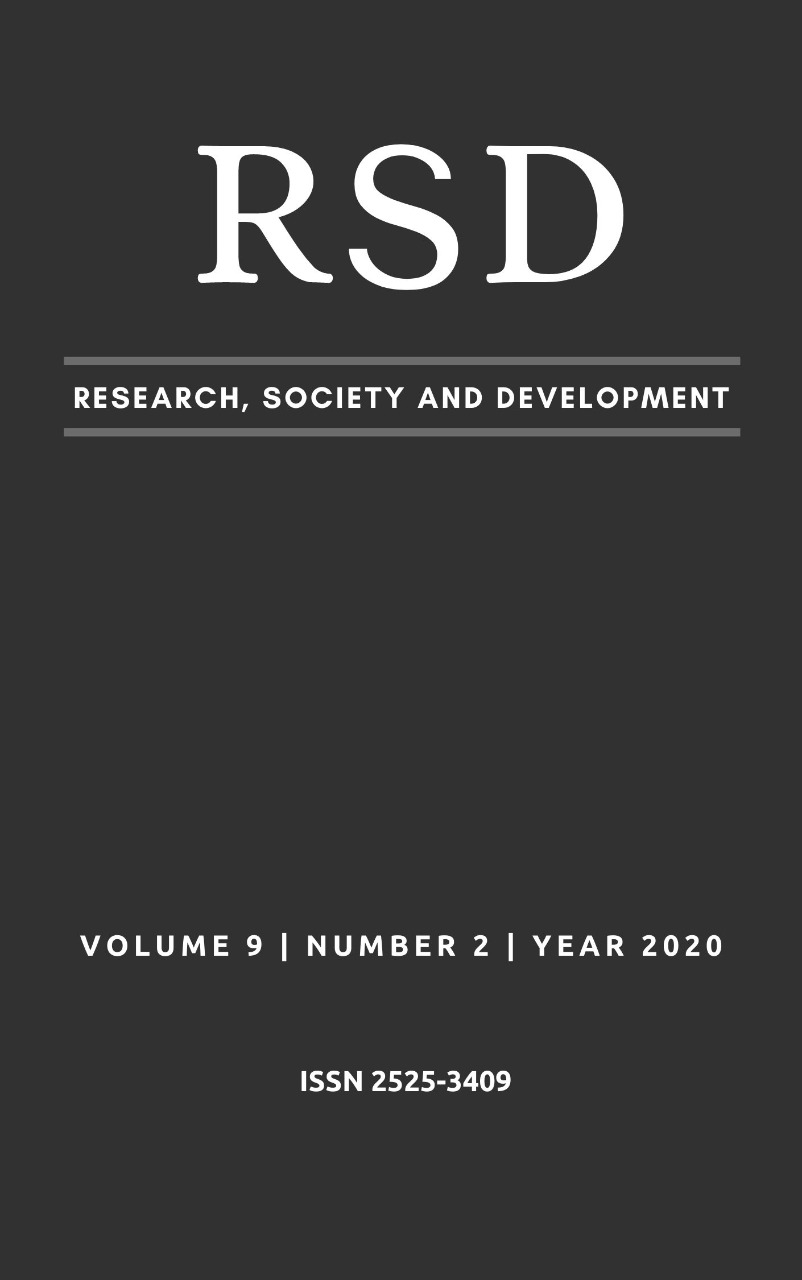Meningite: aspectos epidemiológicos dos casos notificados no estado do Piauí, Brasil
DOI:
https://doi.org/10.33448/rsd-v9i2.2082Palavras-chave:
Saúde Pública, Diagnóstico Meningites, Inflamação das meninges, Epidemiologia.Resumo
A meningite consiste em uma doença inflamatória que acomete as membranas que protegem o sistema nervoso central. Este trabalho objetivou descrever o perfil epidemiológico dos casos notificados de meningite no estado do Piauí nos anos de 2010 a 2017. O presente estudo consistiu em uma pesquisa retrospectiva, com abordagem descritiva realizada com dados secundários obtidos através do Sistema de Informação de Agravos e Notificação (SINAN). Neste estudo foram analisados os casos notificados de meningite no estado do Piauí entre os anos 2010 a 2017. A análise estatística e a elaboração dos gráficos e tabelas foram realizados por intermédio do programa Microsoft Excel e TabWin 3.6. De 2010 a 2017 foram notificados no (SINAN) um total de 2.071 casos de meningite no Piauí (média de 295,8 casos ao ano), dos quais cerca de 61% dos diagnosticados foram do sexo masculino. Neste período, nota-se uma redução constante no número de casos confirmados e da incidência do agravo, variando de 428 casos e 13,61 de taxa de incidência por 100.000 habitantes em 2010, para 129 casos e 4 de taxa de incidência por 100.000 habitantes no ano de 2017. Ao analisar a distribuição de faixas etárias, adultos de 20 a 39 anos foram os mais acometidos pela doença e o gênero masculino predominou em todos os anos. No geral, a evolução do agravo nos três últimos anos registrados no estudo, houve aumento da taxa de letalidade e subnotificação.
Referências
Brasil. (2011). Relatório de Situação: Piauí. Ministério da Saúde. Sistema Nacional de Vigilância em Saúde 5 ed. Brasília.
Brasil. (2016a). Guia de Vigilância em Saúde. Ministério da Saúde. 1. ed. Brasília.
Brasil. (2016b). Situação epidemiológica da doença meningocócica, no Brasil, 2007-2013. Ministério da Saúde. Boletim epidemiológico: 47(29).
Brasil. (2016c). Portaria nº 204, de 17 de fevereiro de 2016. Define a Lista Nacional de Notificação Compulsória de doenças, agravos e eventos de saúde pública nos serviços de saúde públicos e privados em todo o território nacional, nos termos do anexo, e dá outras providências. Ministério da Saúde. Diário Oficial da União, Brasília, DF.
Brasil. (2017). Ministério da Saúde. Meningite: o que é, causas, sintomas, tratamento, diagnóstico e prevenção. Acesso em 29 de outubro de 2019, em http://portalms.saude.gov.br/saude-de-a-z/meningites.
Ceará. (2017). Monitoramento dos casos de meningites no Ceará, 2016 e 2017. Boletim epidemiológico: Meningites. Secretaria da Saúde do Estado do Ceará. Ceará.
Emmerick, I. C. M., Campos, M. R., Schramm, J. M. A., Silva, R. S. & Costa, M. F. S. (2014). Estimativas corrigidas de casos de meningite, Brasil 2008-2009. Revista Epidemiologia em Serviços de Saúde. 23(2), Brasília jun.
Ferreira, J. H. S. et al. (2015). Tendência e aspectos epidemiológicos das meningites bacterianas em crianças. Revista de Enfermagem da UFPE (online). Recife, 9(7), p.8534-41, jul.
Garcia, M. L., Dantas, J. M. C., Malheiro, D. R., Moreira, Í. C. & Lucena, M. M. (2016). Meningite tuberculosa: perfil epidemiológico no Brasil, no Ceará e no Cariri entre 2007 e 2015. Rev. e-ciênc. 4(1), p.61-67.
Guimarães, I. L. B., Guimarães, M. L. B. & Moreira, A. C. A. (2014). Perfil epidemiológico da meningite em crianças. Revista Norte Mineira de Enfermagem. 3(1), p.1-7.
Labiak, V. B., Stocco, C., Leite, M. L. & Virgens Filho, J. S. (2007). Aspectos epidemiológicos dos casos de meningite notificados no município de Ponta Grossa – PR, 2001-2005. Revista Cogitare Enfermagem: 12(3):306-12, 2007.
Pereira, A.S., Shitsuka, D. M., Parreira, F. J. & Shitsuka, R. (2018). Metodologia da pesquisa científica. [e-book]. Santa Maria. Ed. UAB/NTE/UFSM. Disponível em: https://repositorio.ufsm.br/bitstream/handle/1/15824/Lic_Computacao_Metodologia-Pesquisa-Cientifica.pdf?sequence=1. Acesso em: 13 nov. 2019.
Pereira, D. N. (2014). Meningites bacterianas. Dissertação (Mestrado em Ciências Farmacêuticas) – Faculdade De Ciências da Saúde, Universidade Fernando Pessoa. Porto.
Rodrigues, E.M. B. (2015). Meningite: perfil epidemiológico da doença no Brasil nos anos de 2007 a 2013. Trabalho de conclusão de curso (Bacharelado em Biomedicina) – Centro Universitário de Brasília, Brasília. Distrito Federal.
Santa Catarina. (2014). Secretaria de Estado da Saúde de Santa Catarina. Meningites em geral e Doença Meningocócica. Santa Catarina, 2014.
Santos, A. V. (2007). Meningites. Trabalho de Conclusão de Curso do Curso de Farmácia, Centro Universitário Das Faculdades Metropolitanas Unidas. São Paulo, 2007.
Saraiva, M. G. G. A et al. (2015). Epidemiology of infectious meningitis in the State of Amazonas, Brazil. Rev. Soc. Bras. Med. Trop. 48(supl 1), Uberaba.
Souza, C. H., Yamane. A., Pandini, J. C., Cerette, L. B., Ferraz. F., da Luz, L. B. & Simões. P. W. (2014). Incidence of tuberculous meningitis in the State of Santa Catarina, Brazil. Rev. Soc. Bras. Med. Trop. 47(4), Uberaba.
Teixeira, A. B. (2018). Meningite bacteriana: uma atualização. Revista Brasileira de Análises Clínicas. 50(4), p. 327-9.
Waldman, E. A. Vigilância em Saúde Pública. Série Saúde & Cidadania, v.7. São Paulo, 1998
Downloads
Publicado
Edição
Seção
Licença
Autores que publicam nesta revista concordam com os seguintes termos:
1) Autores mantém os direitos autorais e concedem à revista o direito de primeira publicação, com o trabalho simultaneamente licenciado sob a Licença Creative Commons Attribution que permite o compartilhamento do trabalho com reconhecimento da autoria e publicação inicial nesta revista.
2) Autores têm autorização para assumir contratos adicionais separadamente, para distribuição não-exclusiva da versão do trabalho publicada nesta revista (ex.: publicar em repositório institucional ou como capítulo de livro), com reconhecimento de autoria e publicação inicial nesta revista.
3) Autores têm permissão e são estimulados a publicar e distribuir seu trabalho online (ex.: em repositórios institucionais ou na sua página pessoal) a qualquer ponto antes ou durante o processo editorial, já que isso pode gerar alterações produtivas, bem como aumentar o impacto e a citação do trabalho publicado.


